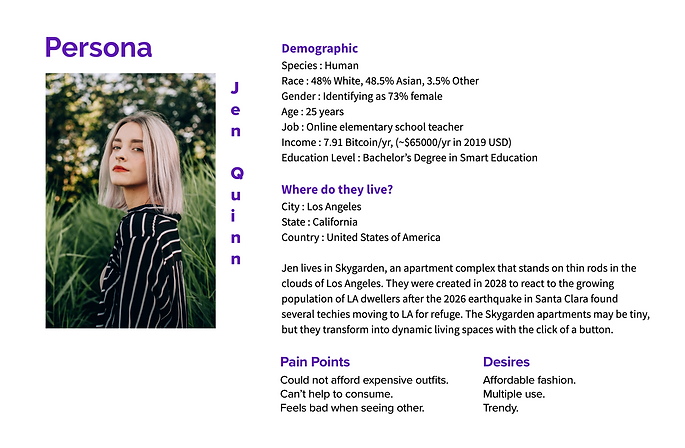SciFi Futures 2034-20
SciFi Futures: Closet 360°

“Solve a problem that you think would exist in the year 2034 by developing a product and its 2020 prototype.”
Object and Spaces, California College of the Arts
Closet 360 is a collaborative project aimed to solve the problem of fast fashion, elevated by the superficiality displayed on social media. This project while considering the advancement in technologies that would take place in the next 15 years, provides a 2034 solution to the problem, along with a 2019 version prototype of the same.
Collaborators: Rachel Poonsiriwong and Lingsou Xie
Understanding the Problem
DATE
1st November, 2018
DURATION
4 weeks
Research (Primary Interviews and Secondary Research Findings).
Taking “superficiality displayed by social media” as the initial problem we tried to narrow it down by conducting primary research (through interviews) and secondary research.
Finally, after synthesizing our research findings we focused our project towards the problem of fast fashion, elevated by the superficiality displayed on social media.

What Problem are we trying to solve?
People interact through online personas that they create through posting content on social media. However, the content celebrated online is mostly untruthful, and often superficial and vain. This creates a judgemental space where people are pressured to compare looks, and wealth online particularly in the form of clothes worn making them want more selections and new styles, resulting in the rise of fast fashion.
Year 2034 Vision

We developed our 2034 vision of the world focused on the problem we aimed to solve.


What is our 2034 Solution the problem?
Outfit-Changing Smart Suit: A form-fitting suit that takes on the shape, color and texture of whatever the user wants to wear. Reframing fast-fashion consumerism through making it unnecessary to purchase styles on a whim. Visualized to help reduce superficiality on social media.


Storyboard
Year 2020 Vision and Research
2020 Research
Keeping the 2034 vision of our product in mind, we to develop a 2020 version of it did secondary research and found out about the technologies available today that could help us develop our product. Further, a 2020 prototype was developed for the same.
What is our 2020 Solution the problem?
Closet 360°: A convertible tunic which pairs with its mobile app counterpart, the latter which alters the tunic’s color and texture. This convertible tunic can be worn 6 different ways.


The product works with the use of its application where the user selects their various options and finally take that up with the use of the smart projector and style changing technology.
-
With it’s the usage of the smart projector, the Outfit changing Smart Suit can change its texture and color to be able to turn into the outfit that the user is looking for.
-
Style changing fabric that can take 6 (or more) forms for the user based on their preference.
-
It has an application to understand your commands and provide you with all the options for the style, texture, and color.

Application


Task Flow


Wireframes
2020 Product
Finally, the functionality of this product was communicated through a video that we collectively produced. Along with this, user testing was conducted to evaluate the product.
Usability Testing

Learnings
-
The Shawl has the potential to be androgynous as well, but only with specific styles such as a cape (for men).
-
If this were to be realized as an actual product, it would not be able to be “one-size-fits-all”, but rather have standard sizes S, M, L due to the constraints in certain styles (for example, putting head through the armhole).
-
Lastly, our interviewees generally felt that it was comfortable, but not when they are wearing something underneath. It might need further research into material to be suitable for cold weather.
Teamwork Process Shot

My role in this collaborative project was embedded in conducting the on-site interviews, storyboarding and collective building of the physical product and its application counterpart. This project enabled me to explore the scope of the technologies today and construct a futuristic tool with them. I struggled with building a product with the limited resources available. This however made me learn to do things with what is available and be frugal. Finally, the next step of this would be to make changes to the physical product based on the usability findings. Along with this, I’d like to incorporate Augmented Reality in the application to make it more interesting.
Conclusion


